|
LOWA RENEGADE GTX MID BOOT
TEST SERIES BY CHAD POINDEXTER
LONG-TERM REPORT
INITIAL REPORT - July 28, 2010
FIELD REPORT - October 24, 2010
LONG TERM REPORT - December 29, 2010
TESTER INFORMATION
|
NAME:
|
Chad Poindexter
|
|
EMAIL:
|
stick1377 (AT) gmail (DOT) com
|
|
AGE:
|
33
|
|
LOCATION:
|
Corinth, Alcorn County, Mississippi, USA
|
|
GENDER:
|
M
|
|
HEIGHT:
|
5' 10" (1.78 m)
|
|
WEIGHT:
|
200 lb (90.70 kg)
|
I love backpacking! However, with only 1 ½ years under my belt so far, I would still consider myself a little green to it all, so to say… Initially, I started out with heavy gear but since then I have gone lighter, although I still use a little of it all. I have gone from tent to tarp, canister stove to alcohol stove, sleeping bag to quilt and quite happily from synthetic to down. All of my hiking so far has been in the South East United States, and up to this point has been with friends or family.
INITIAL REPORT
PRODUCT INFORMATION & SPECIFICATIONS
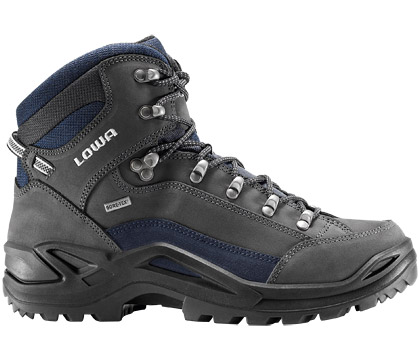 | | Courtesy of Lowa |
Manufacturer: Lowa Boots, LLC.
Manufacturer's Website: www.lowaboots.com
Model: Renegade GTX Mid
Year of Manufacture: 2010
MSRP: (US) $ 200.00
Listed Sizes Available: (US) 7.5 - 12, 13, 14, 15
Size Tested: Men's (US) 12
Listed Weight Per Pair (Men's 9): 2.4 lb (1.09 kg)
Measured Weight Of Pair Tested: 3 lb 2 oz (1.42 kg)
Color Tested: Dark Grey / Navy
Other Colors Available: Sepia & Black
Materials:
Upper: Nubuk leather
Midsole: PU Monowrap Frame (New for 2010)
Lining: Seamless, waterproof GORE-TEX
Outsole: Vibram Evo
Shank: Full length nylon
Foot Bed: Climate control foot bed with comfort perforations to improve breathability.
Derby Style Lacing
Handcrafted In Europe
The Lowa Renegade GTX Mid boots (hereafter referred to as the 'boots") are made to be "phenomenally comfortable, supportive and cushioned." This popular boot has been redesigned for 2010 to be lighter, sleeker, and more supportive. These boots are part of Lowa's All Terrain Collection and "are perennial favorites for day hiking and short-haul, weekend backpacking."
BOOT DISSECTION
UPPER:
Lowa uses Nubuck leather for the upper on the Renegade GTX Mid boots. The Nubuck leather is made from full grain leather which has been sanded down to make it soft to the touch, yet still retains the rugged durability of the full grain leather.
LINING:
Inside the boot, Lowa uses their patented, proprietary lasted method for a smooth and seamless GORE-TEX liner. This method contributes to a more proper fit, which decreases hot spots, thus reducing the risk of potential blisters, all the while doing what GORE-TEX does best: creating a waterproof and breathable barrier.
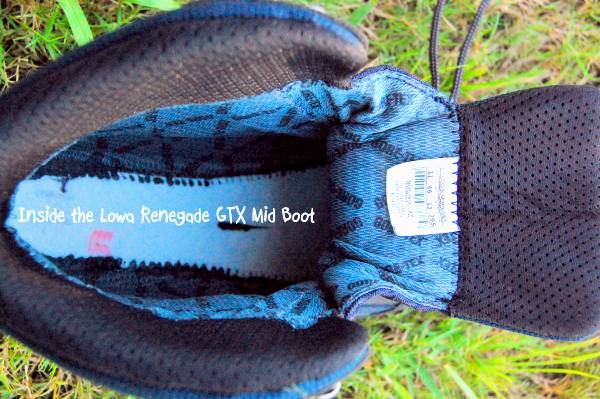
FOOTBED:
The top layer of the climate control footbed (insole) used in the Lowa boots is breathable and moves moisture away from the foot. The second layer is a slow reacting piece of foam which contours to the shape of the foot and eliminates pressure points, resulting in maximum comfort.
MIDSOLE:
New for 2010, the Renegade boots features a monowrap construction midsole. This is essentially a lightweight polyurethane (PU) frame which simply wraps around the boot. This frame is designed to provide lateral stability while allowing the boot to breathe well and still achieve maximum support, while achieving an overall lighter weight.
SHANK:
The Renegade GTX Mid boots features a full-length nylon shank which is sandwiched between the midsole and the outsole. This stiffer, full-length nylon shank is said to "enhance performance for hikers who tackle more rugged terrain." Since the shank is full-length there is complete underfoot protection. Not to mention, the nylon shank is even airport friendly!
OUTSOLE:
Lowa uses the top performing Vibram Evo soles for the outsole on these boots. The Vibram outsoles are a sticky rubber outsole which provides improved grip and shock absorption.
INITIAL IMPRESSIONS
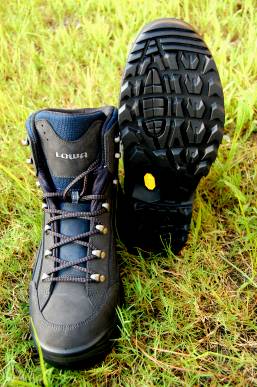 The boots were received as expected in a large "shoe-box" with the information specific to these boots listed on one side. Upon opening the box I found the boots lying on their sides, curled into one another. There were two small booklets and some tags lying loosely inside the box which listed information for proper care of the boots. (All information inside the two booklets was printed in 7 different languages.) The boots were received as expected in a large "shoe-box" with the information specific to these boots listed on one side. Upon opening the box I found the boots lying on their sides, curled into one another. There were two small booklets and some tags lying loosely inside the box which listed information for proper care of the boots. (All information inside the two booklets was printed in 7 different languages.)
I immediately pulled the boots out, and when doing so, the first thing I noticed was how tall these mid-height boots really were, especially when compared to some of my other mid-height boots. From the floor to the top of the tongue measures 8.25 in (21 cm), and from the floor to the top of the back of the boots measure 6 in (15 cm). These boots were much higher than my other boots. This caused me to have a little concern since I have never really worn boots this high.
Nearly the entire boots' upper is made up of Nubuck leather, except for a small portion at the top of the ankle band and a lining on the outside of the tongue which is made up of cordura, or a "textile material." On the inside of the ankle band and the tongue is a softer material with some padding to make the boot fit comfortably around my ankle. This should make hiking in the boots much more appealing by keeping the leather from rubbing the area just above my ankles raw. All stitching appears to be flawless, and rather impressive.
The boots each have four sets of enclosed metal eyelets which run along side the tongue and then three open eyelets which follow the contour of the boot all the way to the top. The tongue is gusseted to prevent water from running into the top of the boots and features a single nylon loop located at the center of the tongue in which the laces can be threaded through to help hold the tongue in place. The laces feel circular in shape with a hollow inner, so when the laces are pulled tight they will flatten out somewhat.
There is a large nylon loop on the back of the heel to assist in pulling the boots on. Also, the new monowrap frame is very obvious as it makes its way around the entire circumference of the boots. I am excited to see how well this new frame will actually help to stabilize my foot while in rough terrain. Lastly the Vibram sole feels very sticky on my concrete floor, but I shall soon see how they do on wet rocks!
The inside of the boot features the seamless GORE-TEX liner which rises all the way up to where the tongue gusset stops. The liner does not appear to extend past this point, which would make sense because at this point water would be able to run into the top of the boots, regardless of the liner. The foot bed is removable and features the Lowa name and the words "Climate Control" printed on the top side of the foot bed.
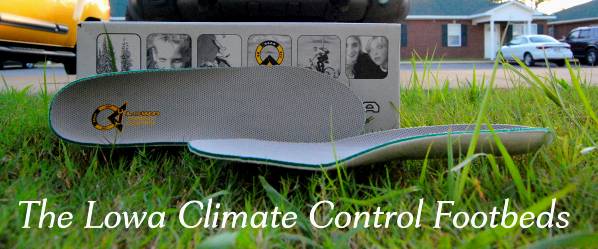
SUMMARY
This concludes my initial report for the Lowa Renegade GTX Mid boots. I would like to extend my many thanks to Lowa Boots as well as Backpackgeartest.org for the opportunity to test these boots. Now it's time for me to get out there and break these boots in, so please check back in about 2 months to see what all I have put them through!
FIELD REPORT
FIELD LOCATIONS AND CONDITIONS
During this testing phase I have put a little over 60 trail miles (97 km) from a few different hikes on these boots and a few more that were not necessarily on a trail. Most of my trail hiking during this phase has been done in the Great Smoky Mountain National Park (GSMNP). Many of the trails throughout the park are in the same general condition, which is well worn, but not necessarily smooth going. These trails are made up of uneven ground and of rocks and roots, both jutting up from the ground as well as lying loose on the trail. There are even some narrow log crossings that cross over the many creeks that follow many of the trails at one point or another. As well, there are plenty of wet spots on the trails that come from the springs that are found all throughout the mountains. These springs are nice, but they result in muddy areas with slippery rocks and/or roots, so close attention must be made each step of the way.
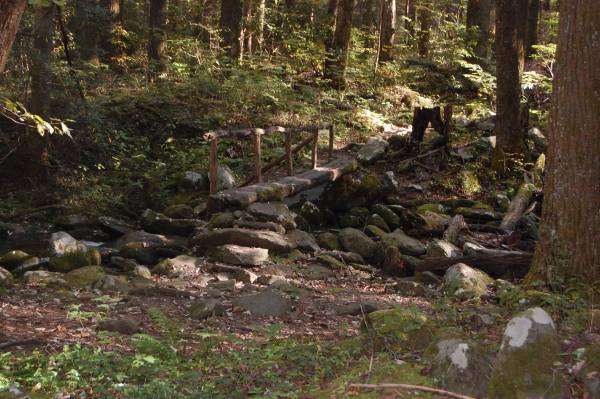 | | A section of trail in the GSMNP |
The first hike I logged while wearing the boots was an overnight hike to Mt LeConte in the GSMNP. We hiked 2,700 ft (823 m) up the 5.3 mi (8.5 km) Alum Cave Trail to the Mt LeConte shelter where we spent the night. Temperatures ranged between 65 to 88 F (18 to 31 C) and the overall conditions were quite humid. For this hike, I carried a 14 lb (6.4) backpack.
The next day I hiked the 0.5 mi (0.8 km) paved trail that climbs 300 ft (91 m) to Clingman's Dome in the GSMNP. The temperature was around 80 F(27 C) and I got a little bit of rain, but it was not even enough to soak through my clothes. For this short hike I decided not to wear a backpack.
I next wore these boots on a day hike to Chimney Tops in the GSMNP. This is a 2 mi (3.2 km) trail that climbs 1,400 ft (427 m). The last 20 ft (6 m) or so of the trail is actually a rock wall that must be scaled in order to stand on the tippy-top of the Chimney Tops. Temperatures were 75 F (24 C), and we were fortunate enough to experience blue skies all afternoon long! On this hike I carried a small day pack that weighed approximately 7 lb (3.2 kg).
Next, my wife and I headed out on a four-day loop hike in the northern section of the GSMNP. Throughout this hike we covered 36 mi (58 km) and what seemed like a multitude of elevation change. We began hiking at an elevation of 2,200 ft (671 m) and the highest point we reached during this hike was 6,300 ft (1,920 m). On our last day of hiking we covered 12 mi (19.3 km) and had a total elevation loss of just over 6,000 ft (1,829 m) and a gain of just over 2,000 ft (610 m). Temperatures ranged from 40 to 75 F (4 to 24 C). The only rain we got was on the last night out, but it poured all night long, which made some of the trail conditions a little more difficult due to some wash outs and muddy areas. My pack weight for this trip started out around 40 lb (18.1 kg) and naturally decreased as the days went by.
The most recent hike where I wore these boots was on an overnight hike to the top of Max Patch in the Pisgah National Forest in North Carolina. We hiked up 329 ft (100 m) from the parking area to the top of Max Patch. Temperatures were between 34 to 60 F (1 to 16 C) but due to the strong winds the temperature felt much cooler than this. Trail conditions here were much more comfortable than on the rugged trails in the GSMNP since this was actually a maintained field so the trail was a soft layer of grass that sat on top of some hard, packed dirt. For this trip my backpack weighed about 30 lb (13.6 kg).
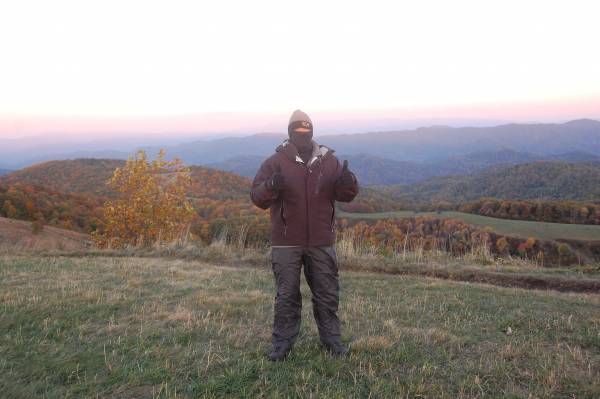 | | On top of Max Patch |
PERFORMANCE IN THE FIELD
I did have some initial concerns when I received these boots, at least when compared to my other mid-height hiking boots. One concern was the height. I was worried that the boots may rub against my legs above my ankles causing some discomfort. One thing that eased some of this concern was that the top of the boot was not made of a hard leather, but rather it is made of a softer cordura and is even cushioned. Of course I wouldn't know how the did until I got them on the trail, so I did...
I tried to take some precautions to make the boots fit well, as well as to not cause any discomfort. One thing I did was always wear a pair of mid-height, medium-weight wool hiking socks with these boots each time I put them on. The socks and the boots fit wonderfully together, and the socks came above the top of my boots so that my skin was not directly exposed to the boots. This worked out well. And what I came to find is that I need not worry about any discomfort coming from the top of the boots rubbing against my leg. The top of the boots provide plenty of cushioning to keep the boot from causing any pain while hiking, even with the boot laces' pulled tight.
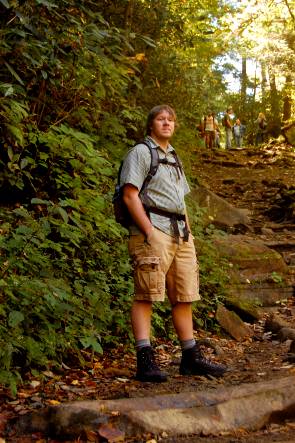
Another lesser concern I had was how would the full-length shank feel. I was worried that the boot would feel stiff. Again, once I got them on the trail, my worries were completely relieved. The full-length nylon shank is actually flexible enough to allow my foot to flex comfortably, without feeling stiff. However, I also found that the true wonders of the shank really shined once I was on my four-day loop hike.
On this hike I was carrying a 40 lb (18.1 kg) pack and walking across some rugged trails. The trails were filled with sharp, jutting rocks and the shanks did a wonderful job at protecting my feet from feeling all of these pointy rocks. This in itself was a blessing. However, on the last two days of our hike, I did begin to feel some of those rocks. I felt the rocks around the outer edges of the sole rather than in the middle, and I noticed I could feel them more when I was descending rather steep slopes. I am sure that some of this was due to the way my feet were slapping against the ground as I was trying to keep myself from running down the steeply-descending trails, but this makes me wonder how wide the shank is. I will definitely be sure to keep a close eye on this and see if I can figure out anything else about this during the last testing phase of the report.
One last concern I had was how well the insoles would cushion my feet. In my other boots I immediately changed out the insoles because they were just too thin and uncomfortable. When I received these I was pleased to see that they were in fact at least a little thicker than some of the other stock soles I have seen. Now that I have put a little over 60 mi (97 km) on the boots I can say that I have been happy with them. Now though, my concern is how well will they continue to hold up?
I have yet to wear the boots while hiking in direct rain, but I have been sure to submerge them in water while on the trail. I have actually made it a point to walk through the puddles and small creeks rather than around or over them while wearing these boots. In doing so, I have successfully submerged the boots in water nearly up to the point where the GORE-TEX liner stops, and so far they have not let a drop of water inside. Also, I have noticed that while walking through the creeks, the water will bead up and roll off of the boots nicely, leaving the boot looking quite dry immediately after stepping out of the creek.
The boots have seen a fair share of mud as well, which makes the many small creeks nice to come across since I can wash the mud off a little as I walk through them. However, once I arrive back at home after each hike I am sure to clean the boots as needed. That may just be washing them off in the bath tub using a little water and a tooth brush or, if needed, using some of the Nikwax Footwear Cleaning Gel to really scrub them down. Also, at this point I have used the Nikwax Nubuck & Suede Proof treatment on the boots once. At this point, the boots still look very good, especially knowing what I have put them through...
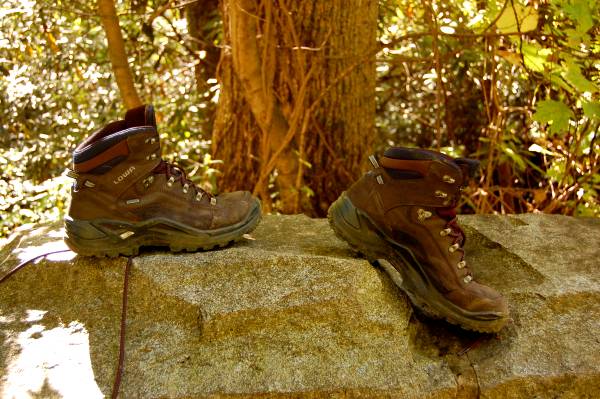 | | After my day hike to Chimney Tops |
I have also noticed that the boot laces do not hold very well, especially when going down hill. Initially I found myself stopping frequently to re-tighten the boot laces, and like I said, more so on steep down hills. At one point I decided to try a double-knot at the top. This worked out a little better, however, I would still on occasion have to stop and retie the laces. On the last day of my loop hike in the GSMNP I knew that I would encounter a lot of trails going down hill, so before I hiked out that morning I tied a single-knot in the laces each time I laced them through the eyelets (locking the laces) and then also tied a double-knot in the laces at the top. This did in fact hold much better. However, I would like to see some laces that held better used on these boots.
Other than this, the boots did a wonderful job. The motion-control was great, making it very easy for me to securely plant my foot where I wanted and to step through the way that I wanted. A few times I accidentally stepped on a rock wrong and felt my ankle start to twist, but these boots did a great job at helping me to quickly correct it and kept me from causing some damage to my ankles.
Also, the Vibram sole did a great job at gripping the many wet, slippery rocks and roots that I hiked through on the trail. This even includes some rock-hopping that I did across some of the wider creeks. There were a few times that my foot would slip a little, but some of this was due to my footing. All-in-all, the soles have done a wonderful job and I am happy with them.
SUMMARY
I had some mixed feelings about these boots when I first received them; however, over the course of this testing phase I have come to really like the boots. The boots are comfortable while wearing, do a great job at keeping my feet dry, provide great foot support and has protected my ankles more than once, already. Also, the soles do a great job at sticking to the ground, even wet slippery ground.
At this point, I am curious as to the exact dimensions of the shank and will be sure to pay close attention to this as I go through the next phase of the testing series. I am not sure if they are coming up short, or if I was just being extra rough on the boots. Also, I would like to see a different boot lace used on this boot. This is the only real "negative" thing that I have to report about these boots at this time.
So, I will see if any of this changes during the next couple of months. So check back around the first of January for the last segment of the report.
LONG-TERM REPORT
LONG-TERM TEST LOCATIONS AND CONDITIONS
During this testing phase I had the pleasure of wearing the Lowa Renegade boots on three separate hikes, two of which were day hikes and one which was a single overnight trip. During this time I logged another 33 mi (53 km) in these boots on hiking trails and quite a few more on paved surfaces (wearing them around home and town).
Both of my day hikes were at Big Hill Pond State Park in Tennessee. Elevation at the park ranges between 380 to 611 ft (116 to 186 m). Generally, the trails located here are hard, packed dirt with occasional rocky areas. Also, at this time of the year most of the trails are padded with fallen leaves. Some areas can be a little muddy, but these areas are mainly found on the trails that briefly follow a lake shore. On both of these hikes I carried a day pack, which weighed about 10 to 12 lb (4 to 5 kg), and covered an estimated 21 mi (34 km) total between these two hikes.
During the first trip the temperature was 50 F (10 C) and the skies were a little overcast, but I was lucky enough not to receive any rain. The second trip was a little better with temperatures near 60 F (16 C), but yet again, overcast skies and luckily again, no rain.
Most recently I wore the boots on an overnight trip to the Sipsey Wilderness area within the Bankhead National Forest located in Alabama. On this trip we hiked approximately 12 mi (19 km). The terrain here is typically hard packed dirt (also at this time of the year this trail is covered in fallen leaves as well) with occasional rocks. On this trip we encountered multiple water crossings in which I was able to either rock hop across or the water was low enough for me to simply trudge right through. Elevation changes here were very mild and I generally stayed at an elevation of 700 ft (213 m). The temperatures on this trip ranged from 17 to 42 F (-8 to 5 C). And while we did not receive any rain on the trip, we did arrive just after a very heavy rain storm so the trail and the creeks were good and wet.
PERFORMANCE IN THE FIELD
When I initially received the boots I assumed that that they would keep my feet warm simply because of the padding and the fact that they are GORE-TEX lined. Thankfully, during this final testing phase the temperatures were indeed a little cooler than they were during my other testing phases (as low as 10 F/-12 C) and I found that my assumption is indeed true. I have worn these boots while in wet conditions and in below-freezing temperatures while wearing a simple pair of medium weight wool hiking socks with the boots and my feet have stayed both dry and warm. As well, wearing these same socks with these boots have continued to provide me with a very comfortable fit throughout the entire test series.
The trails and conditions I hiked in during this testing phase were a little more forgiving than the terrain I have hiked on during the last phase. As a result, I did not have some of the same concerns that I had during the last testing phase.
While the trails I hiked on during this time had their fair share of up's and down's, they were not as severe as they were in the Great Smoky Mountains. Due to this I have not had any problems with the boot laces holding. On each trip I started out without locking the laces and simply tying a single knot once I laced them up and much to my surprise this has worked well. There has been a few occasions in which I have snugged them up a little while stopping for a break or a lunch, but they have not become near as loose as they had on my previous trips to the Smokies. However, after the experience I had with them during the last phase, I would still like to see a pair of boot laces used on these boots that gripped better and did not come loose so easily, even on extreme downhills...
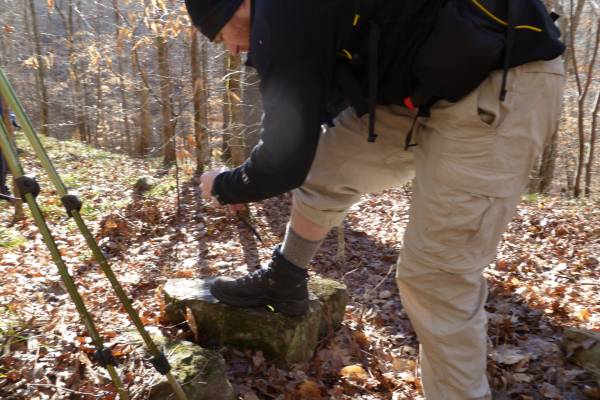 | | Tying my boots |
Also, since I did not hike across hardly any rocky or uneven ground on these trips, the full-length shanks did a great job at protecting my feet. Also, concerning the shanks, I was a bit skeptical as to how stiff the boots would be and if I would notice the rigidness when flexing my foot while walking with a full length shank in them. After wearing them for the last few months though, I realize that the boots are not stiff like I had feared.
All in all, I have had a very good testing experience during the last two months. I have been very happy to have had them for the hikes that I did.
SUMMARY
Initially, I had some slight concerns about these boots; however, during my time wearing them I gave way to those concerns and have actually become very impressed with them. Overall, the boots are very comfortable. I was also pleased that I simply ordered my size and they fit me great right out of the box, which does not always happen. The quality of the boot is very nice. There were no flaws in the boots when I received them, and now despite the mud and creeks that they have been through, and even after 100 trail mi (161 km) on them they are still in great condition.
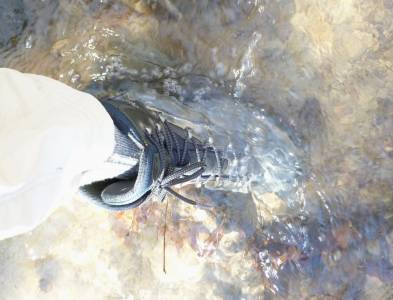 | | Standing in a creek |
For the most part, the boots function just as I had expected them to by reading the information found on the website.
The monowrap midsole in conjunction with the mid-height tops have in fact provided plenty of support and stability during my hikes. Also, thanks to the open monowrap design, my feet never overheated while wearing them, even in the humid, 80+ F (27+ C) temperatures.
The insoles have held up much better than I expected. At this time, they are not flat and I don't feel like I am walking on a board while wearing the boots so I am very impressed with these insoles. Also, to date, I have yet to feel even a hot spot while hiking, so the fear of forming blisters while wearing these boots is not a concern for me at this point. Regardless, I will more-than-likely be changing them out for some gel inserts within the next few months simply due to my personal preference.
The soles are still in great shape and show few signs of wear. No cracks or torn lugs, but the soles are quite scuffed up (probably due to the rocks in the Great Smoky Mountains...) The Vibram soles have done a good job at gripping rocks, although I have found that careful foot placement is the first real step towards not busting my tail!
I have also been very happy with the ease in which the boots are able to be put on or to remove. When the laces are not laced through the open eyelets at the top of the boot, the boot is super easy to put on (or take off) and really requires no effort at all . The generous sized heel loop which is designed to assist with pulling the boots on is really not needed after all. As a result of the boots being super easy to put on or take off (as well as being comfortable), I have stopped carrying a separate pair of camp shoes while backpacking. So, even though the boots are not super-light, the weight still evens out by not carrying another pair of shoes for camp.
During my field reporting I had experienced a little discomfort around the edges of my foot after a few days of hiking on the very rocky and uneven trails in the Great Smoky Mountains. This lead me to wonder how wide the shank actually is, which lead me to contact Lowa about the size of the shank. Initially I emailed Lowa via the "Ask Us" feature found on the bottom of their web page. Two days later I got a response which simply asked me to contact their customer service team and gave me a phone number. I called and my call was answered on the third ring. I explained the situation to the customer support rep which I was speaking too, and he measured the width of the shank Lowa uses in this boot for me on the spot. He informed me that the shank in this boot measures 3 in (7 cm) in width across the ball of the foot and 2 in (5 cm) across the heel. By these measurements, a majority of my foot is protected by the shank, except for the very outer edges of my foot which is where I felt the discomfort. So, maybe my tender feet were just not ready for all the rocks. I do plan on wearing these boots back to the Great Smoky Mountains National Park more and will continue to evaluate this aspect of the boots.
So, my only concerns with the boots are the laces not holding tight at times and the discomfort I experienced on the outer edges of my feet. One other thing that I do not necessarily agree with is the "lightweight" term used to describe this boot; however, this is a bit subjective due to my pack weight finally getting smaller! On the other hand, there are many great things about these boots that have influenced me enough to happily wear these boots until they actually break down. They are as follows:
LIKES:
1. Comfortable right out of the box.
2. Durable.
3. Highly waterproof.
4. Great foot control.
5. Breathes well.
6. Good traction.
7. Slips on/off very easily.
DISLIKES:
1. Laces don't always hold well.
2. Not exactly "lightweight."
3. Experienced some discomfort around the edges of my foot after hiking on lots of loose rocks for a few days.
CONTINUED USE
Now that my backpack weight has dropped considerably, I am planning on trying some lightweight trail runners, especially for late spring, summer and early fall. However, I fully intend on continuing to use these boots for all of my winter hiking/backpacking trips until they fall apart! I will actually be wearing them next weekend on a three day hike in the Great Smoky Mountains.
Again, I would like to take this time to thank Lowa as well as BackPackGearTest.org for the opportunity to have tested these boots. It has been a pleasure!
SIGNATURE

Chad Poindexter
"Stick"
This report was created with the BackpackGearTest.org Report Writer Version 1.5
Copyright 2011. All rights reserved.
Read more reviews of Lowa gear
Read more gear reviews by Chad G Poindexter
|




